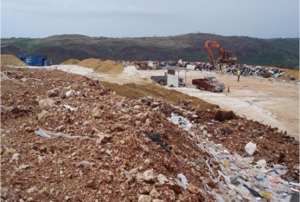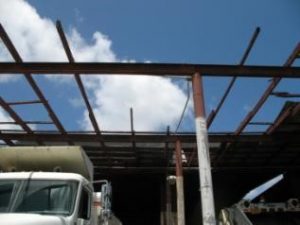Comprehensive Solid Waste System Planning (Receivership of the Guam Solid Waste Management Division, United States District Court of Guam)
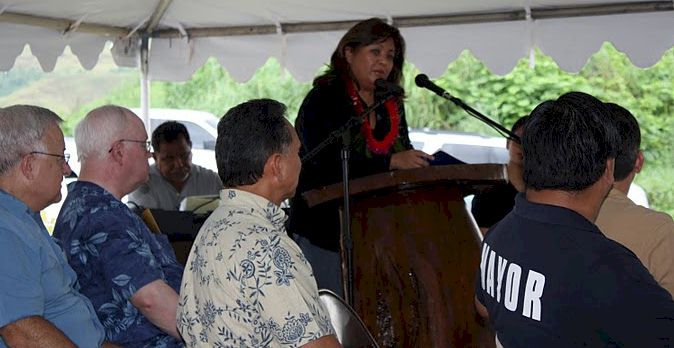
Frances M. Tydingco-Gatewood, Chief Judge, District Court of Guam, delivers remarks during ceremonies commemorating the permanent closing of the Ordot Dump.
In March 2008, Chief Judge Frances Tydingco-Gatewood of the United States District Court of Guam issued a court order appointing GBB as Receiver to achieve what the Government of Guam was unsuccessful in reaching during the previous 22 years – compliance with the Clean Water Act through compliance with the 2004 Consent Decree. When the Judge tasked GBB with implementing the Consent Decree, it required a 180-degree turnaround of a completely dysfunctional solid waste management system while closing a dump that has been open for nearly 70 years. The Consent Decree, signed between the Government of Guam and the United States Environmental Protection Agency on February 11, 2004, ordered the Government of Guam to close the Ordot Dump, cease all discharges into the Lonfit River, open a new municipal solid waste landfill facility, and develop and implement recycling and hazardous waste strategies to reduce the volume of materials going into the landfill.
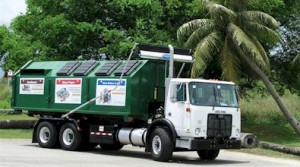 Inheriting a solid waste management system plagued by serious operational, financial, and administrative problems; known and unknown environmental issues; and decrepit facilities, GBB assembled a multi-disciplinary team of solid waste, procurement, landfill engineering, financial, and communication experts to develop a turnaround plan and present to the Court a roadmap to accomplish the Consent Decree projects and reform Guam’s solid waste management system.
Inheriting a solid waste management system plagued by serious operational, financial, and administrative problems; known and unknown environmental issues; and decrepit facilities, GBB assembled a multi-disciplinary team of solid waste, procurement, landfill engineering, financial, and communication experts to develop a turnaround plan and present to the Court a roadmap to accomplish the Consent Decree projects and reform Guam’s solid waste management system.
 Working with GovGuam, the U.S. military, private waste haulers, and other stakeholders in Guam, GBB has closed the Ordot Dump, opened a new sanitary landfill, implemented recycling programs, opened a new household hazardous waste facility and upgraded Guam’s residential transfer stations, in full compliance with the requirements of the Consent Decree. This has been accomplished under the guidance of the Court and in consultation with the U.S. EPA and the Guam Environmental Protection Agency.
Working with GovGuam, the U.S. military, private waste haulers, and other stakeholders in Guam, GBB has closed the Ordot Dump, opened a new sanitary landfill, implemented recycling programs, opened a new household hazardous waste facility and upgraded Guam’s residential transfer stations, in full compliance with the requirements of the Consent Decree. This has been accomplished under the guidance of the Court and in consultation with the U.S. EPA and the Guam Environmental Protection Agency.
In a court order issued April 29, 2019, the Chief Judge partially ended GBB’s 11-year federal receivership over Guam’s solid waste and disposal services, effective at close of business on April 30, 2019. Per the order, administrative and managerial responsibility over the Guam Solid Waste Authority (GSWA)’s day-to-day operations was returned to the Government of Guam while GBB continues its technical work to complete the post-closure plan for the Ordot Dump.
For more information about the Receivership, visit the Guam Solid Waste Receivership Information Center or see the following documents:
- Overview of the Guam Solid Waste Management Receivership
(presented to the U.S. District Court of Guam on March 6, 2019) - From 0 to 180: Transforming Guam’s Solid Waste Management System from the Ground Up
(article by Chris Lund, GBB Senior Vice President, published in WasteAdvantage magazine in June 2015) - 180º Turnaround for a Solid Waste Management System: The Guam Story & Lessons Learned
(article by Chace Anderson, GBB Principal Associate, published in WasteAdvantage magazine in February 2012)
State of Solid Waste Management when GBB Became Receiver:
In 2008, when GBB was appointed as Receiver, the solid waste management system was plagued by serious operational, financial, and administrative problems; unknown environmental issues; and decrepit facilities, including:
-
Ordot Dump out of regulatory compliance for 22 years
- Daily leachate discharge, polluting nearby river and groundwater
- Odors and garbage fires
- Improper daily cover
- No gas and groundwater monitoring, let alone gas collection
- No scale to accurately calculate the tonnage of waste disposed
- New landfill neither permitted nor built
- 3 residential transfer stations not permitted with unknown environmental issues
- Inefficient solid waste operations
- Trash collection service inconsistent, weeks behind schedule
- Customer complaints high
- Financial issues
- Revenues did not support operational costs
- Unreliable billing system with only 68% of service billings collected
- No financing plan to raise estimated $160 million capital needed to undertake Consent Decree projects
-
Poor condition of transfer stations and facilities
- Most facilities not renovated in 25+ years despite multiple typhoons and earthquake that weakened the structures
- Faulty electrical systems
- Substandard working conditions for staff
- Morale at all-time low
- Offices and employee facilities in unsafe conditions
- Staff not supplied adequate tools and systems
- Outdated, at risk, computers systems
-
Trucks and equipment aged and in disrepair
- Only one truck operational
- Unprocessed requests to fix equipment
- Unreliable support from two rented trucks
- $11,000 per day spent on rental equipment, equipment and contract operators
- Lack of services
- No recycling programs on island; 2% diversion vs. 25% required by Guam law
- No residential bulky waste or recyclable collection offered
- No regular HHW collections or permanent facility to handle
Key Accomplishments:
GBB staff placed priority on taking immediate steps to improve customer service and financial accountability, reduce costs through operational efficiencies, preserve disposal space at the existing dump until the new landfill could be built, and address long-term issues of financing Consent Decree projects – all while procuring and managing the design, permitting, and construction of the new landfill. Virtually no aspect of solid waste management remained untouched during the first year. Among the accomplishments achieved:
Financing, Capital Funding, and Communication Services
- Provided analysis and recommendations for financing the Consent Decree projects, working with the Government of Guam to successfully issue long-term bonds
- Established, with the approval of the Court, a financial management strategy for the receivership that facilitated the receivership and ensured the money is used only for solid waste purposes
- Established and engaged in regular communications with the media and public via the website and ongoing media correspondence.
Operational Reforms
- Improved trash collection services, dramatically reducing customer complaints
- Repaired vehicles and purchased new equipment to support operational needs
- Reduced the solid waste workforce by more than 35% as operations were reorganized and streamlined for more efficient organization and delivery of services
- Significant cost savings with dramatic reductions in cost of leased equipment from $11,000 per day to just $484 per day. Improved working conditions for employees including functional equipment, working bathroom/shower facilities, clean kitchen facilities, and personal safety equipment and uniforms
- Implemented a ban on vegetative waste, cardboard, and wood entering the Ordot Dump, which increased recycling and extended the capacity of the dump
- Added recycling drop boxes at the dump and three transfer station/convenience centers
- Implemented cart-based residential waste collection services.
Consent Decree Infrastructure Development
- Prepared cost estimates for engineering, permitting, construction management, and construction for all Consent Decree projects.
New Landfill
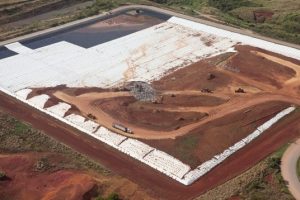 Completed the hydrogeological investigation for the new landfill site
Completed the hydrogeological investigation for the new landfill site- Completed redesign of the first phase of landfill development – 22 acres of lined landfill in two cells, with all ancillary systems for a greenfield landfill site
- Completed design of a new 3.5-mile two-lane secondary island road. This serves as a service access road to the landfill and can support semi-trailer truck transport that can weigh 43 tons when fully loaded
- Completed design and construction of a 5.5-mile gravity/force main sewer line with 4 pump stations that linked the landfill to a publicly owned wastewater treatment plant to handle proper disposal of leachate
- Managed rezoning of land from Agriculture to Landfill, as appropriate
- Managed the performance of a leachate treatability study with bench scale studies to confirm treatability at plant
- Executed permitting for all local and federal permits needed for construction and operations
- Developed and initiated Detection Monitoring Program for the landfill operations with report results sent semi-annually to local regulatory agencies
- Developed and executed the wastewater treatment monitoring plan to evaluate the impact of the leachate on wastewater treatment plant performance
- Developed and executed environmental monitoring plan for landfill operations including stormwater, gas, and groundwater
- Responsible for, and performed, construction management services throughout project
Dump Closure
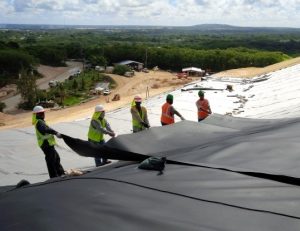 Developed and procured engineering and environmental services for the closure investigation and design
Developed and procured engineering and environmental services for the closure investigation and design- Conducted a comprehensive environmental investigation to establish the baseline environmental conditions at the dump to support the closure design. Design included leachate and landfill gas generation analysis to support decisions on treatment and potential for energy conversion
- Developed closure design alternatives and recommended an alternative to regulatory agencies
- Developed all permitting documents and achieved approval for construction
- Performed all construction management oversight and execution of construction contracts
- Officially concluded the Environmental Closure of the Dump, on March 28, 2016, to protect the surrounding environment
Residential Transfer Station Design
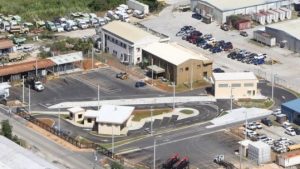 Developed renovation plans for three existing transfer stations and one new transfer station that also housed a full-service Household Hazardous Waste Facility
Developed renovation plans for three existing transfer stations and one new transfer station that also housed a full-service Household Hazardous Waste Facility- Conducted environmental assessments to establish existing environmental conditions and performed supplemental investigations that involved sampling plans for surface and subsurface soil, as needed
- Oversaw all designs and provided quality control and assurance for each aspect of the design efforts
- Initiated and completed all permitting for construction and operations permits
- Responsible for, and performed, construction management services for all sites
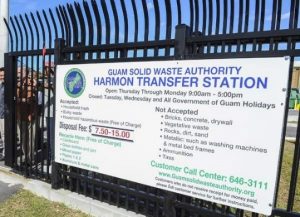 Household Hazardous Waste (HHW) facility and Harmon Residential Transfer Station
Household Hazardous Waste (HHW) facility and Harmon Residential Transfer Station
- Conducted procurement for construction of the facility
- Responsible for, and performed, construction management services throughout project
- The HHW facility, an essential requirement of the Consent Decree, officially opened January 23, 2015
Key Milestones:
Closing of Ordot Dump and Opening of Layon Landfill
On August 31, 2011 and September 1, 2011, two events were held to commemorate completion of key milestones in bringing Guam’s solid waste system into compliance with the 2004 Consent Decree for violation of the Clean Water Act: the official opening of the Layon Landfill and the closing of Ordot Dump to waste disposal operations.
The Layon Landfill is a high-tech, environmentally sound and highly controlled landfill for non-hazardous municipal solid waste. It was built with an engineered liner and a leachate collection and removal system that protects human health and the environment. With a capacity in excess of 15.8 million cubic yards, the Layon Landfill will service the island of Guam for more than 40 years.
Environmental Closure of the Ordot Dump

Frances M. Tydingco-Gatewood, Chief Judge, District Court of Guam, during the Hearing officially concluding the Environmental Closure of the Ordot Dump.
On March 26, 2016, the District Court of Guam held a Hearing that officially concluded the Environmental Closure of the Ordot Dump. The Dump was in operation, beginning in the 1940s until August 31, 2011, polluting the Lonfit River in violation of the Clean Water Act. Working in conjunction with the U.S. EPA, the Guam EPA, the Ordot Mayor’s Office, and the people who live in the immediate vicinity of the Ordot Dump, the Receiver oversaw the design of an approved plan that met all of the legal and environmental requirements of the Federal and Territorial Governments.
The plan provides for the legally required 30-year post-closure care of the facility that includes monitoring groundwater, leachate collection and control, methane gas collection and control, and financial assurance that the money will be available to carry out these activities. Leachate, which had been leaking out of the Ordot Dump and polluting the Lonfit River, is now being captured and diverted to a waste water treatment facility for proper treatment. The environmental closure of the Ordot Dump also captures harmful methane gas, a greenhouse gas that contributes to climate change.
Procurements:
GBB, in its capacity as Receiver for the Solid Waste Management Division (now the Guam Solid Waste Authority), has presided over several procurements including, but not limited to:
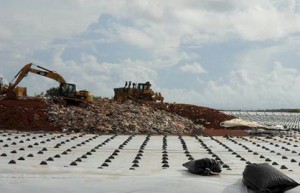 Request for bids for construction of the Landfill Operations Road and Mass Grading for Cells 1 and 2. Three bids were received and after careful review, the Receiver awarded a contract
Request for bids for construction of the Landfill Operations Road and Mass Grading for Cells 1 and 2. Three bids were received and after careful review, the Receiver awarded a contract- Invitation for Bids (IFB) to procure carts with riveted RFID tags attached and cart lifters to attach to existing trucks, and have these items delivered to a staging area on the Island of Guam. GBB was part of the team that subsequently evaluated the bids received
- Request for proposals (RFP) for technical assistance services for the initiation of groundwater quality monitoring activities for the Layon Municipal Solid Waste Landfill
- IFB for the construction of Layon Municipal Sanitary Landfill, Entrance Area Facilities, and Cells 1 and 2. Three firms submitted bids and a contract was awarded after careful evaluation of the Receiver
- RFP for Construction Management Services for Layon Landfill Systems, Entrance Facilities, and Access Road and Utilities
- RFP for a firm to prepare final closure and post-closure plans of the Ordot Dump in compliance with the Consent Decree and RCRA Subtitle D, 40 CFR Part 258. The scope of work includes all of the site investigations and studies needed to support the plans and survey work needed to sort out numerous land ownership issues in the area. Five firms submitted proposals and the Receiver awarded a contract after a thorough evaluation process
- RFP from qualified Operators for services to operate the new Layon Municipal Solid Waste Landfill in compliance with the Consent Decree for seven years, with an option for two five-year extensions. The contract was awarded after a thorough evaluation process managed by GBB
- Request for Expressions of Interest to provide a Municipal Solid Waste (MSW) Transfer Station and transportation of MSW from the Transfer Station to the Layon Landfill
- RFP for the services of a contractor with demonstrated knowledge and experience in Household Hazardous Waste Facility Operation management
- RFP for construction management services for the construction of Ordot Dump closure systems, wetland restoration, Dero Road improvements and utilities for the Ordot Dump Closure Construction
- IFB for the construction of the environmental closure of the Ordot Dump & Dero Road Sewer Improvements
- IFB for processing of residential recyclables
- IFB for the construction of Harmon Residential Transfer Station
- IFB for roll-off containers and stationary compactors
Community Meetings Concerning Implementation of Cart-based Collection System
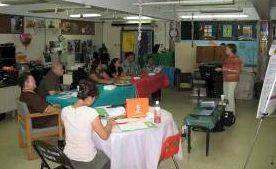 Three community meetings/small group discussions were held with Guam residents in the south, central, and northern village districts. The meetings were intentionally small, ranging in size from six to 11 participants, in order to provide opportunities for candid, in‐depth discussion of solid waste issues and the trash cart rollout plans. A total of 27 residents participated, representing the villages of Umatac, Agat, Merizo, Tamuning‐Tumon‐Harmon, Chalan Pago‐Ordot, Mangilao, Barrigada, Piti, and Hagatna Heights. A series of stakeholder discussions was also held to obtain input from a select number of mayors, environmentalists, school officials, business representatives and media regarding the Receiver’s plans for implementing a new, cart‐based collection system for customers of the Guam Solid Waste Authority (GSWA).
Three community meetings/small group discussions were held with Guam residents in the south, central, and northern village districts. The meetings were intentionally small, ranging in size from six to 11 participants, in order to provide opportunities for candid, in‐depth discussion of solid waste issues and the trash cart rollout plans. A total of 27 residents participated, representing the villages of Umatac, Agat, Merizo, Tamuning‐Tumon‐Harmon, Chalan Pago‐Ordot, Mangilao, Barrigada, Piti, and Hagatna Heights. A series of stakeholder discussions was also held to obtain input from a select number of mayors, environmentalists, school officials, business representatives and media regarding the Receiver’s plans for implementing a new, cart‐based collection system for customers of the Guam Solid Waste Authority (GSWA).
Public Education for Cart Rollout Plans
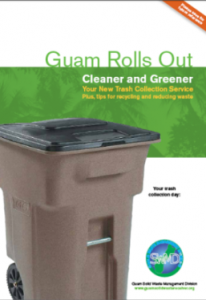 As part of the successful rollout of a new cart-based residential trash collection system, GBB developed a public information strategy to maximize residents’ participation and ensure a successful rollout. Tools developed included website content, news releases, detailed registration information, brochures, and cart hangers. The response from residential customers to the new trash cart system was very positive. The initial supply of 7,000 carts was exhausted before a second shipment arrived. Demand for the new cart was so strong that a third shipment was required in order to complete the delivery of carts to new customers. Overall, 19,090 carts were delivered, an increase of 6,501, representing a 52 percent in total residential customers.
As part of the successful rollout of a new cart-based residential trash collection system, GBB developed a public information strategy to maximize residents’ participation and ensure a successful rollout. Tools developed included website content, news releases, detailed registration information, brochures, and cart hangers. The response from residential customers to the new trash cart system was very positive. The initial supply of 7,000 carts was exhausted before a second shipment arrived. Demand for the new cart was so strong that a third shipment was required in order to complete the delivery of carts to new customers. Overall, 19,090 carts were delivered, an increase of 6,501, representing a 52 percent in total residential customers.
Curbside Recycling
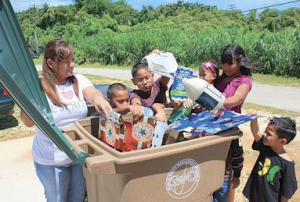 GBB originally implemented a curbside recycling pilot program for 1,000 customer households with cart-based collection of fiber, plastics (PET and HDPE), and aluminum and bi-metal cans. The objective of the pilot project was to determine the feasibility of implementing curbside recycling collection services throughout Guam for all GSWA customers.
GBB originally implemented a curbside recycling pilot program for 1,000 customer households with cart-based collection of fiber, plastics (PET and HDPE), and aluminum and bi-metal cans. The objective of the pilot project was to determine the feasibility of implementing curbside recycling collection services throughout Guam for all GSWA customers.
After a successful pilot project, an island-wide curbside recycling program was implemented for collection of paper (magazines, copy paper, newspaper, cardboard, cereal boxes, and other paper), aluminum and metal cans, and plastics 1 & 2 beverage containers every other week.
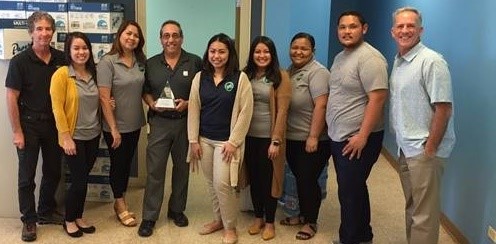
The Ordot Dump Closure project on the island of Guam earned the 2016 Construction Management Association of America’s Project Achievement Award in the $50 Million and under Infrastructure Project category. The award recognizes outstanding achievements in construction and program management.
What They Said
“The court is very proud of the work accomplished by the Receiver [GBB] over the last 11 years. The Ordot Dump has been closed, and the Receiver has installed the necessary systems to protect Guam’s waters from this environmental hazard that had plagued the island for decades.
The Receiver has built a modern solid waste system for the island which includes a compliant solid waste landfill, a recycling program and a household hazardous waste disposal center.”
Chief Judge Frances Tydingco-Gatewood
statement in Court Order dated April 29, 2019
“It was 16 years ago that the consent decree was filed by the appropriate parties. It [Ordot Dump] is finally closed and I am very, very happy.”
Chief Judge Frances Tydingco-Gatewood
statement at a Hearing held March 28, 2016
“The court compliments the Receiver’s continued efforts to ensure GSWA remains financially sound. The Receiver’s strong fiscal management will assure successful completion of the Consent Decree projects.”
Chief Judge Frances Tydingco-Gatewood
statement in a Court Order dated October 26, 2015
“After approximately three years and five months since its appointment, the Receiver has effectively dealt with many challenges to reach two major milestones under the Consent Decree—the closing of the Ordot Dump and the opening of the Layon Landfill. The court commends the Receiver for its efforts and the tremendous progress it has made thus far.”
Chief Judge Frances Tydingco-Gatewood
statement in a Court Order dated September 2, 2011
“Despite [the] challenges, the Receiver has turned the formerly defunct SWMD into an efficient, reliable, and self-financing government entity. In addition to improvements at the SWMD, the Receiver has made significant strides in fulfilling the requirements of the Consent Decree.”
Chief Judge Frances Tydingco-Gatewood
statement in a Court Order dated September 2, 2011
“The federal receiver, Gershman, Brickner & Bratton Inc., has the island’s thanks for fixing and improving the government’s solid waste program.” […] “In short, the receiver has transformed the way the island deals with its waste.”
Pacific Daily News editorial dated August 30, 2011
“But the real reason for the recent boom in recycling has been the court-appointed federal receiver, Gershman, Brickner & Bratton Inc., which took over [Guam] solid waste operations in March 2008. It’s done more for recycling than all local elected officials in the past few decades. […] We commend the receiver for doing what’s right, pressing forward with recycling, when our own elected officials lacked the political will to do so. And we strongly encourage residents — whether they’re included in the pilot project or not — to do what they can to recycle more.”
Pacific Daily News editorial commending the work done by GBB as
Receiver for the Solid Waste Management Division of the Department of Public Works,
Government of Guam, November 14, 2010
“The court finds the work performed by GBB and SWMD employees in concert with the various governmental agencies over the last two years truly impressive… What was once perceived as an insurmountable hurdle is now becoming a long awaited reality for the people of Guam.”
Chief Judge Frances Tydingco-Gatewood
statement in a Court Order dated April 9, 2010




